Text
Hand in File:
As always below is a list of what content should be within the hand-in folder for this module:
Artefact:
Blank and prototype renders
Sketchup file of exhibition
DAE file of Exhibition
Finalised content renders
Moving image of Exhibition
Branding: Logo, colour palette and style sheet
Dissertation:
Dissertation Proposal
Dissertation Evaluation
Blog:
HTML Link
PDF Blog
0 notes
Text
Finishing Statement:
As with all of my modules I like to finish off the blog with a finishing statements about what I enjoyed about the module, what I found interesting and what I would have done if there had been more time.
This semester I was able to branch out further into the world of User Experience Design and learn ever more about the profession. I have no regrets on this topic and if anything I feel more than happy that I switched topic have way through last semester in Level 5 to change to this topic area. I feel as though not only have I gained a lot of insight for my dissertation itself, but also for me as an individual wanting to potentially go into the User Experience Design profession. Without doing the research in which I did for this semester I don’t think I’d know half of what I do nor would II be able to apply it to my own work if I hadn't have conducted such research. I feel very much that I have widened my skillset as a UX Designer as a result of this.
For my artefact, I feel as though I was able to use my consistently improving 3D modelling skills into this module and create something in I have been really proud of. After spending hours and hours working once pr 3D modelling software and hours trying to find a rendering software in which works well for me has really paid off this semester. Although the content adding portion of the model was long winded and very time consuming, I am more than happy with the results.
As for if I had more time, I’d definitely find more primary research for my dissertation and if anything more research in general to write even more than I did this semester. I almost felt myself holding back on expanding on sections too much because of the world limit being in place. For the artefact, I would have definitely enjoyed marketing the exhibition but due to the time restrictions this would not have been possible.
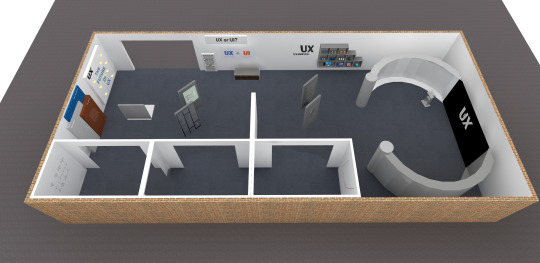
0 notes
Video
This is the video animation of the Sketchup file of my Exhibition space for my Dissertation artefact.
0 notes
Text
Editing the Animation Footage:
Most times when I render Sketchup files as an animation the footage lags and pauses at each frame. Therefore I wanted to make sure it runs more smoothly. To do this I brought the animation into After Effects to cut out the pauses within the animation:

I then added a fade out within the video footage to make it all flow a bit better rather than have rough edges.
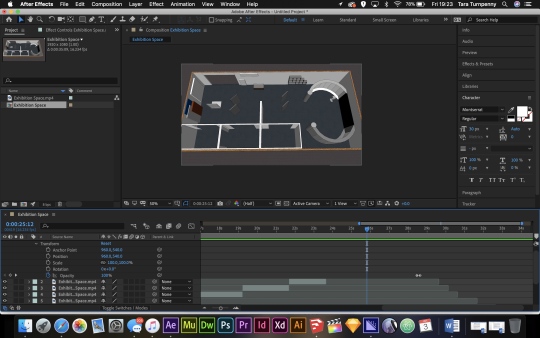
Following this, I added the footage into the Media Encoder queue ready to export the video as an MP4 file.
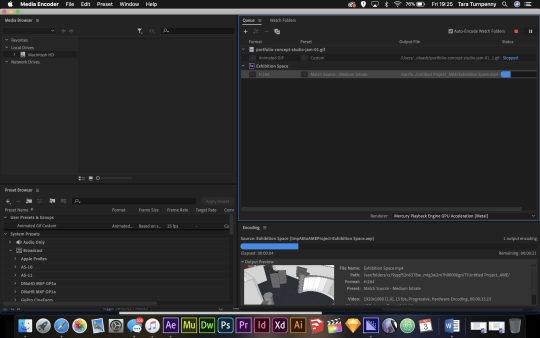
0 notes
Text
Creating an Animation of the Exhibition Model
I wanted to create video footage of the original model before it was full rendered, this way it is easier to see the process of making the artefact and what it looked like without content but just as a base model.
Therefore I began creating scenes within Sketchup of the Model ready to render out as an mp4 file.

0 notes
Text
Updates to Trello:
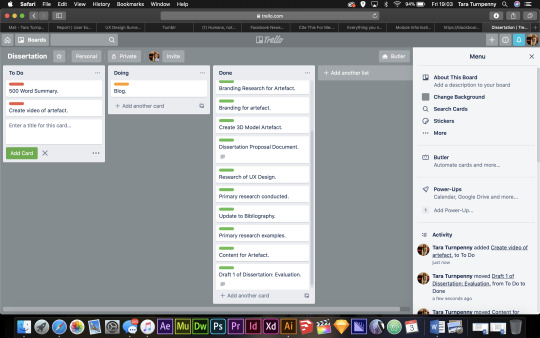
Above you can see the current state of my Trello board for this module. As you can see, everything is near enough done other than the round off of this blog, a 500 word summary to end the blog and also a video piece of the artefact exhibition.
6 days towards submission I aim to have all of this complete by the end of this day ahead of next week.
0 notes
Text
Proof Reading the Evaluation:
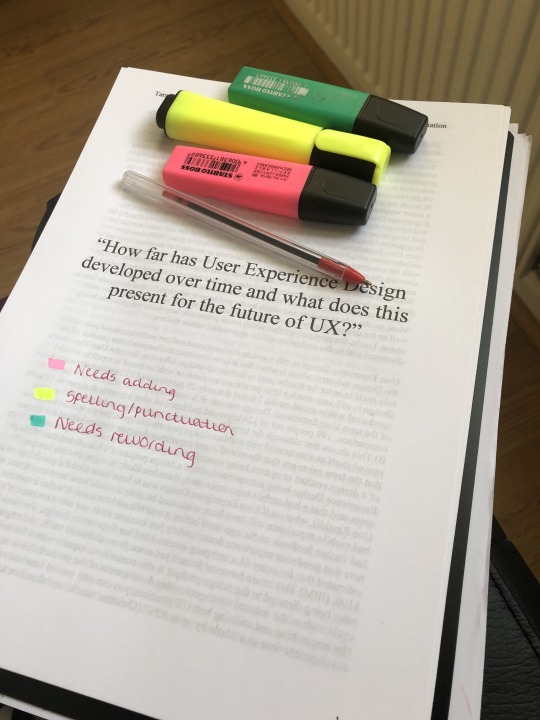
Before hand when I got to 2500 words I printed off the document in order to proof read, re word sentences that didn’t make much sense and also see where I can add extra detail within the text itself. I feel this is a lot easier to do on paper with highlighters and a pen over just reading it over and over again on the computer.
Once I reached the word count earlier this morning I repeated this step and printed the full document off ready for me to proof read. I colour coded the full document and amended within the pieces of paper any changes in which I needed to do on the word document before and in.
Despite me already proof reading the first 2500 words beforehand I still managed to find typos and changes to the text in which I needed to do. This highlights the importance of checking and re checking pieces of work before submitting them. You can easily miss out minor mistakes that can look very obvious to other people.
Once marking out the paper copy of the evaluation, I then used it to go through the word document to amend any in which I had highlighted within the paper copy.
I will be repeating this a further third time before hand in.
0 notes
Text
Results of the Primary Research Survey:
Although I didn’t get as many responses as I hoped for, I still managed to collect some data from the online survey in which I conducted. There was still some valuable answers in which I was able to use within my dissertation evaluation. Below you can see a spreadsheet version of the responses in which I was able to get from the survey:

There is also a portal in which I can view each survey answers. On a whole, the answers were pretty much very similar in terms of they believe UX Design should be taught more within education, as well as it is important to have a UX Designer within a design team.
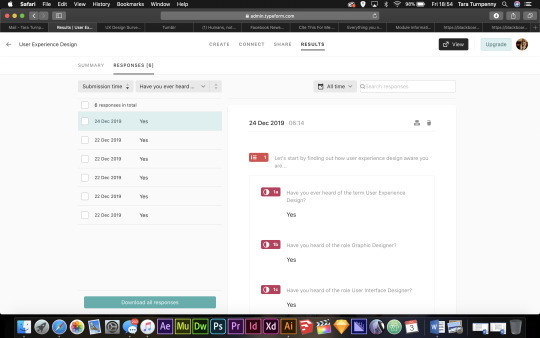
You can also view the results here:
https://tara729446.typeform.com/report/rF2zOn/0itU30WrKNbN21mG
0 notes
Text
Creating an Instagram Poll to get Primary Data
Since my Dissertation topic surrounds digitalisation of a product and therefore not something physical. I feel social media and the user journeys of these services have a big part of user experience design. At the end of the day, if the social media is successful such as the likes of Instagram, Facebook and Twitter: then the user experience design must have been successful in achieving this as it has made users want to keep coming back to have more.
There was two key findings in which I wanted to find within the introduction portion of my dissertation evaluation: how many people have heard of User Experience Design, and how many people have heard of Graphic Design. I wanted to prove that although UX is a relatively old term now, people still do not know it exists. Whereas Graphic Design you can study as a course and most people do know what it is.
I felt the best way in which I could get this data was to use Instagram polls on stories and make my followings into good use.
Therefore, I put the question out to my followers for 24 hours. This was a very easy way for people to answer, all they had to do was tap ‘yes’ or ‘no’.
Below you can see the Instagram story for UX Design:

Below is the next story which was asking about Graphic Design:

24 hours later I got the results, and to my expectations I was correct that people do not or have not heard of User Experience design, whereas most people had heard of Graphic Design:
Below is the results of the User Experience Design poll:

and below is the Graphic Design poll results:
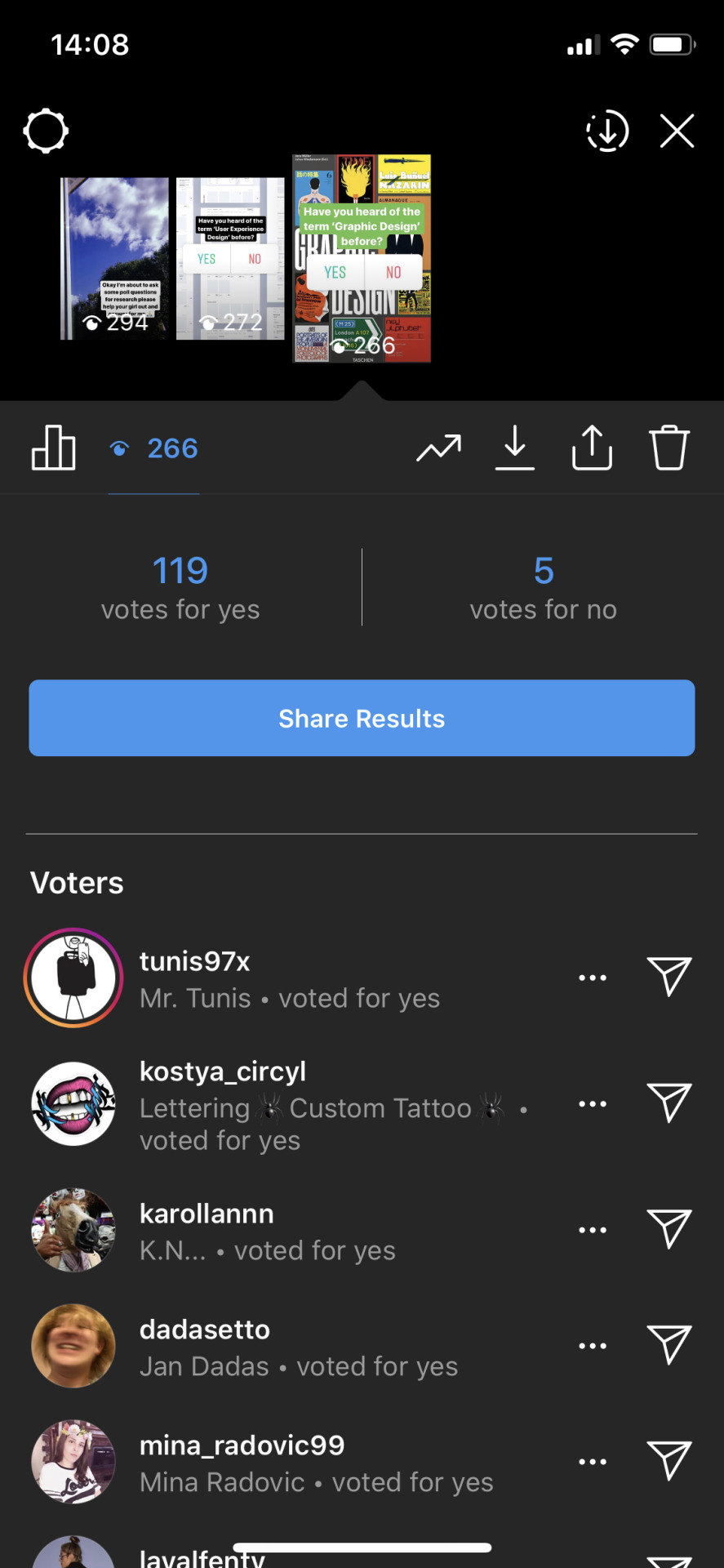
0 notes
Text
Article: Designers are using “dark UX” to turn you into a sleep-deprived internet addictDesigners are using “dark UX” to turn you into a sleep-deprived internet addict
https://qz.com/1058674/facebook-news-feed-design-and-dark-ux-are-turning-us-into-sleep-deprived-internet-addicts/
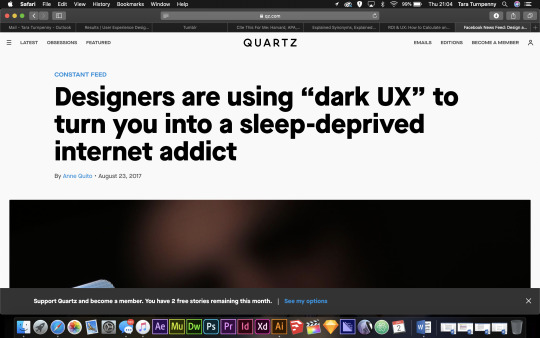
I have heard the term ‘dark UX’ before but not sure where I had heard it from until I found this article. I thought it would be useful and interesting to see this bad side of User Experience Design despite it being so important in order for websites and services to work to their best potential. There is always two sides to things and I want to approach both of them and come to my own conclusion on it.
Notes from this article:
Of course, the goal of any good design is to keep users engaged. But in the case of Facebook and other social media, “engagement” can easily become into “can’t-stop-scrolling,” or even addiction. The result is an often overlooked ethical conundrum to designers creating digital experiences: When is design too engaging for users’ own good?
By improving the News Feed’s design, Facebook’s UX designers are eliminating all obstacles to cue users to curtail their time on the platform. ”When the interaction is smooth and requires no thought or difficult-to-remember steps, the behavior will more likely and easily become automated and rewarding,” Turel and Bacharal explain to Quartz. “[Facebook’s] ultimate objective with these moves is to retain users’ attention and keep them scrolling, posting and using their sites.”
Inside the world of “dark UX”
UX design’s founding principle is utopian. According to Norman, “the first requirement for an exemplary user experience is to meet the exact needs of the customer, without fuss or bother.” Addictive, well-designed interfaces mean that UX designers are doing their jobs. And micro visual cues like a bigger “Buy Now” button, or flashy testimonials, can be just as much value-neutral tools of the trade as they are tactics in the battle for your attention.
Deloitte Digital’s UX competency lead Emily Ryan describes the tricky line designers walk every day: “At the end of the day, it’s extremely tough to say ‘no’ to a product manager who’s telling you to add some feature that we know the user doesn’t want, doesn’t need and ultimately will mar their experience in some form.” Ryan, whose personal website is aptly named “UX is everywhere,” says that conscientious designers will propose alternatives to dirty, manipulative design tactics called “dark UX“.
Dark UX is an industry term for sly design tricks that benefit the client’s bottom line. It ranges from creating defaults, such as a pre-checked opt-in email subscription or pre-selecting the most expensive options. It can also manifest in the form of interfaces requiring clients to supply their personal information before being allowed to look at the products on a website.
0 notes
Text
Article: When does good UX become a problem?
https://medium.com/@cphil1708/when-does-good-ux-become-a-problem-38f6dd7e3274
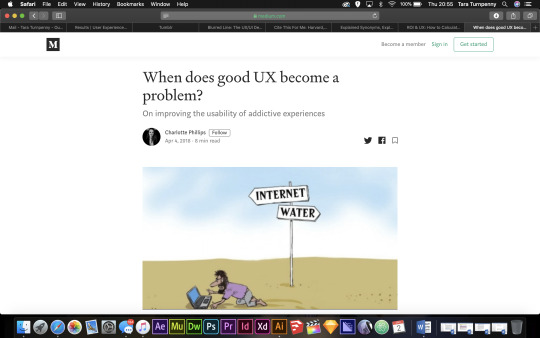
Moving forward on this topic I needed to know a bit more about this other side of UX Design to gain a greater understanding, both for the dissertation but also for me as an individual to have awareness on the effects good UX can actually cause on the users and how I could potentially avoid this within my own designs.
A classic case of UX facilitating addiction is the gambling industry. The Gambling Commission has estimated that the number of gamblers has grown by a third in the past three years (Davies, 2017). This is influenced hugely by digital platforms bringing ease of use and accessibility. There’s an interesting juxtaposition whereby UX teams now have to include warnings and information about gambling addiction, whilst working to improve ease of use. Gaming is another dangerously addictive industry being improved by UX. In 2013, the American Psychiatric Association included Internet Gaming Disorder in the appendix of the updated version of the Diagnostic and Statistical Manual for Mental Disorders (Kuss and Fernandez, 2016).
User Experience is fuelled by a society focused on consumerism that demands instant gratification and conflates pleasure & efficiency with happiness. We want everything quicker and easier. UX Design makes use of this to fix problems people aren’t even aware they have in order to create a product that will make some money.
UX Designers research carefully. From the insight they gain, they identify opportunity to improve and begin a design process. This process is constantly iterative. UX Design teams are constantly finding new ways to increase engagement with their digital products. It goes something like this:
Improved usability = elimination of pain points = increased engagement and time spent.
The future of UX Design:
All this boils down to the bigger question of how technology is revolutionising our world as we know it. So far, UX Design is responsible for incredible improvements to our lives. But could this become a problem in the future? How much can technology remove us from our human world and replace our needs with digital solutions, and how easy will we, as UX Designers, make that?
We are already talking to products. Behind Amazon Alexa and Google Home is a team of designers ideating on how to remove even more user pain points. The movie ‘Her’ solves the problem of loneliness in a digital way through the use of AI to create a computer that replicates an actual human mind. The pain of love is removed in a relationship with a robot. This technology already exists and is being utilised more and more frequently. How far will this be taken in the future? Might this ‘addiction’ to digital become an undeniable reality? Are we being blinded by good UX?
Imagine a world where UX Designers have removed every possible pain point of a physical world through user centred design.
0 notes
Text
Why good UX Design can be seen as a bad thing:
Previously in another blog post in a Ted Talk video I made notes of the effects of which good UX Design can actually have a bad effect on society. A side in which I never actually thought about in relation to this topic before. However, I feel it is important to go into this problem and give a flip side to the arguement why UX Design is so important and more so how could the future of UX change this.
In addition to this, it ties in really nicely with my current negotiated brief topic of internet addiction where by I can use my found research of that brief to bring into my dissertation evaluation.
Key statistics of internet addiction:
The world's population is roughly 7 billion people, so that makes for about 420 million people addicted to the internet. https://www.businessinsider.com/420-million-people-are-addicted-to-the-internet-study-2014-12?
https://www.therecoveryvillage.com/process-addiction/internet-addiction/related/internet-addiction-statistics/#gref
77% of American adults go online every day
43% go online several times a day
26% are online almost constantly
8% go online once a day
11% go online a few times a week
11% don’t use the Internet at all
In addition to this internet addiction isn’t only a bad thing for health but multiple other factors also such as relationships.
0 notes
Text
Proof that User Experience Design Works:
https://www.impactbnd.com/blog/roi-ux-how-to-calculate-and-prove-the-value-of-user-experience-design

When beginning the dissertation evaluation I was trying to justify why User Experience Design is so important, however I quickly realised that statistics would be one of the best ways in which I would be able to prove this to someone reading the evaluation. Although it makes sense that it is important when explaining it with my own words; there’s no hard evidence to back it up. When essentially yes, if you do all the user testing, research and prototypes the product should work better...but there’s a possibility it will not. Therefore I wanted to find evidence to back myself up on the importance of UX Design:
Key Facts from this Article:
Even big name companies are concerned about the benefits of optimizing for their users. IBM stated in their write-up on User-Centered Design that “every dollar invested in ease of use returns $10 to $100.”
These returns however don’t just come back from the traffic being directed towards the product because of the good user experience design however:
Reduces Wasted Development Time:
By researching and utilizing best UX practices, you can stop wasted time and reduce development time as a whole by up to 50%.
And if you still believe the consequences of avoided research aren’t that high, you’re wrong. Trying to remedy an error after development is up to 100 times more expensive as it would of been prior.
Decreased Customer Support
Your users shouldn’t have to be trained on using your software or website just because you know internally how it works, it’s not worth spending time and money into teaching them if it’s too complicated to begin with.
If you do have software that needs to have some instructions accompanied with it, then it’s best to at least create streamlined documentation that ultimately reduces the amount of time you need to put into training the end user.
Otherwise, if you product isn’t designed for them, you end up with an increased amount of calls to your support, causing you to hire more people to support the demand for help.
Increases Your Sales
Increased Customer Retention:
And if you’re looking for numbers, 14.4% more customers are willing to purchase another product if your software doesn’t meet their expectations. But if you do manage to please your users, 16.6% of those who become customers are likely to recommend your product. (Forester)
0 notes
Text
Video: The Importance of UX Design
An interview with Jonathon Steingiesser: lead UX Researcher, MYOB
https://youtu.be/mhYkfcEhHVA
youtube
Notes from this:
Research: most people try to skip this step, they just want to go straight into developing and designing.
Picking the right UX tool at the right time and unpacking the problems and recommendation.
The longer you spend designing, marketing and strategising without talking the customer, the more waste potentially you are creating.
How would you go about creating this task? Is a key question when testing prototypes.
You can create prototypes on almost anything to user test. You don’t need a polished product.
No need to over complicate things and build complex things which customers may not understand.
Lose sight of what the one thing people are looking for.
0 notes
Text
Video: Why UX Design is a Proble
https://youtu.be/dpXBV3COwJM
youtube
Notes from this:
Design has a lot of creative qualities to it, but UX Design is so much more. It’s like a research and psychologist all in creativity at once.
Knowing how to take triggers and return them with products that customers love to go back to everyday.
E.g. bad UX Design of password creations being too difficult.
32% of bad experiences came from people abandoning the product.
33% of divorces in the UK blame Facebook, does this mean that UX Design working so well can cause more real life problems?
Children spending too much money on computer games, or 30% of our productive time being spent on social media all caused by design decisions.
Snapchat streaks: the users take it very seriously. Was meant to be a fun design within the app but turned into something that was competition based and anxiety causing. Creating fear of missing out.
We make these design decisions to optimise for longer uses. But we do underestimate the impact it has on our relationships, health, life and future society.
We create these products out of fear of missing out.
We create products that we can become addicted to great user experience.
This is a direct result of a lack of broader thinking.
As a designer, we are basing our decisions on short term goals: more users, longer usage time. We do not understand the impact in which this has.
We need to shift the way we think, beyond engagement levels, the user, and design products for not when they’re being used but when they are not being used too.
Notifications to get people back into the app is another method to ensure longer usage and return rates.
Start basing our design decisions on the human beings we are designing for. Helping them for fill their purpose in life.
There are efforts being made: e.g. instagram removing the like feature to remove the social anxiety caused by the number of likes you get.
But it is also the really small decisions, for example removing the red notification symbols. Removing one primal trigger and replacing them with a different symbol and creating a more mindful experience.
Start making the right decision decisions, because the ones we make today do make an impact on the future of the global design.
0 notes
Text
8 challenges to UX design in the enterprise
https://xwerx.com/blog/8-challenges-to-ux-design-in-the-enterprise/
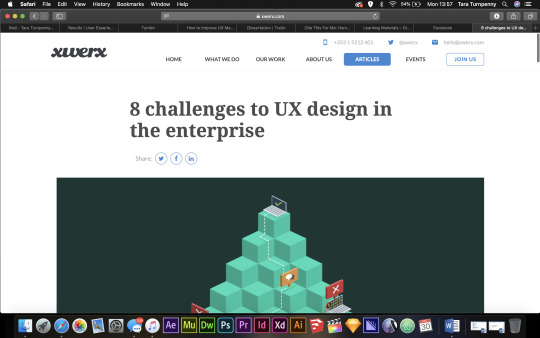
This article goes through the problems in which UX Designers face within the design industry. Including problems in which I raise in my evaluation outline such as some CEO’s and higher ranking people within the industry who doesn’t work necessarily on the front line doesn’t know or understand what UX Design is therefore it would be naturally harder to get them to invest in it.
Moreover, the point in which I make regarding the blur between design roles making it harder to give tasks within a design team as they can sometimes overlap. Also causing problems as UI Designers may want something to go in a certain place for aesthetic purposes, however a UX Designer may not due to the research in which they have conducted. Additionally another example would be SEO and UX Designers may have conflicting research and findings and therefore will have conflicting ideas within the design life cycle.
—————————————————————-
1. UX Misunderstood
At the start of a UX project, there’s often a misunderstanding. “Some stakeholders may have no idea of what you’re here for. They may think they already know what their users want. They just want the thing they’ve made looks better”, says Xwerx’s Head of UX, John Mooney.
2. Collaboration Resistance
Multidisciplinary teams are at the heart of user-centred design. “By creating interactions between product managers, developers, QA engineers, designers, and marketers, you put everybody on the same page and on the same level”, writes Jeff Gothelf, author of Lean UX. In practice, collaboration can face management resistance and a long tradition of organisational silos. “Silos are the death of collaborative teams ”, warns Jeff Gothelf. “As a result, conversation across disciplines wanes and mistrusts, finger-pointing, and “cover your ass” (CYA) behavior grows.”
3. Organisational rigidity
“Most enterprise clients have their own project management techniques that don’t jive with a healthy user experience design workflow” , writes Jordan Koschein in a post called UX for the Enterprise. The “waterfall” model – or any linear process – is doomed. Agile methodology has overcome the challenges of continuous release and user feedback. Integrating UX into a company’s own variation of development sprints, however, is rarely a walkover.
How to deal with this:
“Rome wasn’t built in a day. You won’t change a development process that has possibly been in place for decades overnight so you need to think about building a “customised variation” of it. Pick your opportunities to introduce leaner development cycles, do it gradually and always seek to show the value of the new approach” , says Xwerx’s Director, Sean Murphy. Otherwise, you’ll get stuck with project approval processes and tonnes of requirements which are almost immediately out of date.
5. Legacy UX “Debt”
When starting a new project, UX designers and developers often have to contend with years of cruft that have obscured tools and processes. Under the pressure of short deadlines or now forgotten business requirements, the company has, consciously or not, sacrificed the design to improve … later. This “debt”, an analogy developed by Ward Cunningham, has many bad consequences, writes Maiz Lulkin . It destroys accountability and “erodes trust between management and the tech team, sometimes permanently”.
How to deal with this:
Forget about the “big bang” approach to the UX debt. Most products can’t be rebuilt from the ground up. Start by identifying the key pain points of the legacy product. From there, create a plan to tackle these incrementally . Often, UX can be improved with the minimum amount of change. For example, information architecture is always a good candidate for improvement. Helping users to navigate effectively in the application (e.g., understand where they are and how to get back to where they came from) is an obvious UX activity that’s often overlooked. Take a look at the 10 Nielsen’s general principles for interaction design as a good starting point for identifying these pain points.
8. The buyer IS NOT the “end-user”
In enterprise UX, notably when dealing with BtoB applications, the distance between a product’s end-users and the decision makers might be longer than the corridors. “The end user is chronically under-represented as the purchasing process is dominated by C-level decision makers and other senior personnel” , remarks Murray Nolan, Senior UX Analyst with Xwerx. “The end users sometimes have little or no say in whether they use the product or not. It is bought and implemented on their behalf.”
0 notes
Text
Focusing on Collaboration to Improve UX Maturity in Your Organization
https://xd.adobe.com/ideas/perspectives/leadership-insights/how-to-improve-ux-maturity-collaboration-awareness/
Below is an article which can be used as secondary research in relation to UX Design not having a clear cut job role, whether it mixes other design jobs within it or just is a stand alone roll. She goes on to explain that there is no start or end as of yet to UX Design however, this could somewhat be used to an advantage to prove that UX Design does have an impact, more so to be ambiguous with the role as it isn’t clear cut.
Could this mean that the misconception and less understanding of the role mean you’ve actually got more freedom creatively within it?

Where does UX’s role end and others begin?
One of the reasons I wanted to talk to Rachel about these topics was a tweet she posted, saying “I still struggle to understand/decide where my role ends and others begin.” UX can seem like a fuzzy role at the best of times, and this is a sentiment I’ve heard echoed by lots of designers. Rachel shared her perspective that:
Key points from this:
Does UX Design still not have a clear cut role? Do they just do whatever the other roles are not doing to fill in the blank?
UX Design differs in each job role, there is rarely ever two UX Design roles that are the same.
A lot of designers must feel the same about this issue. This could be a leading question for my primary research.
“There are so many parts to UX, for example collaborating with other people and their clients, as well as understanding where the line is between a design practitioner and a manager. A big question for me a few years in to working in UX is, ‘how do I relate, not just to other departments, but to other, perhaps more senior UXers and product managers?’ Our field is still not that well defined, and it can be confusing!”
Key points from this:
How can UX Designers prove themselves to higher ranking roles within the design industry?
Where is the line drawn for a UX Designer to complete their role?
Attempting to define and differentiate all of the different roles, skillsets, and career paths is something that the design industry struggles with on an ongoing basis. And of course, it is also something that is continually evolving as new domains (such as UX research or content strategy) gain importance and slot in to the picture. In my experience, being open and curious goes a long way. A growth mindset will help you dodge the feeling of ‘being threatened,’ and seeing potential in the contributions that adjacent domains can make. Additionally, this ambiguity, while frustrating at times, allows for immense potential to carve your own unique path.
For Rachel, it starts with trusting that UX has something valuable to offer. “Belief that your ideas and your work matter is a really important starting point. UX can be fuzzy, and I’ve seen people get really stuck in a mindset that it’s hard to ‘show’ the value of UX design, so they hold on really tightly. Instead, you need to believe and trust that your team, clients, and leadership will value UX’s contribution to strategy, to product direction, to understanding true user needs. That way you don’t get bogged down in trying to justify your work.”
0 notes